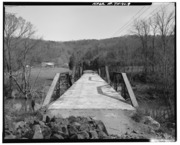Products
The Wrought Iron Bridge Company specialized in relatively short-span iron truss bridges. Most were built for highway use, as the railroads were all privately owned at the time and employed their own engineers. The company supplied a catalog of bridge designs and mass-produced the parts to build these designs. Once a bridge was ordered, the pieces were shipped by train to the nearest station. Thus, local contractors were able to assemble a bridge very quickly, much like a model.
1882 pamphlet

An illustrated pamphlet, dated 1882, is available online. In this pamphlet, Wrought Iron Bridge claims that "during the past 18 years this firm have erected nearly 4,300 spans, varying in length from 20 to 300 feet." At the time of publication, the company had worked in 26 US States, Canada and Mexico.
Wrought Iron Bridge were able to assemble their bridges very quickly and the pamphlet claims that they "have completed 100 to 140 foot spans at points from 100 to 300 miles distant from our works in 8 to 15 days." They were not quite as fast on larger bridges, but the "350 foot bridge, 38 foot wide, built at New Philadelphia, Ohio, was completed for travel in 40 days from the receipt of the contract," a speed unheard of for modern construction, often because of legal red tape.









